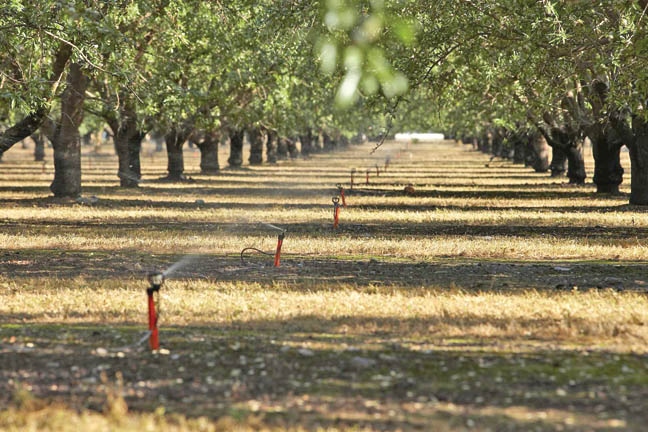September 16, 2010

Those who have been around the almond industry for 20 years or more will remember the bumper sticker that said, “Happiness Is a Ton of Almond Meats per Acre.” A ton was considered a very good yield and a cause for happiness. Now, a ton of meats is the industry average yield.
This is an illustration of how far we have come in terms of boosting our productivity and efficiency, and, at the same time, implementing environmentally responsible orchard practices. Research — much of it funded by the Almond Board of California (ABC) and led by world-class specialists — has been key to the success.
Many factors contribute to this progress. For instance, my July column (Western Farm Press, July 17, 2010 — Almond industry reaps many benefits from Nickels Soil Lab) reviewed the impact of micro and drip irrigation and the important role research conducted at the Nickels Soil Lab in Arbuckle played in the introduction of these irrigation systems. A second important factor is irrigation scheduling, and an example is the importance of postharvest application during bud differentiation in late August and September to assure next season’s crop production.
Another important yield factor is nutrition. Results of an ABC-funded survey of growers conducted in 2007 have just been published in the July-September issue of California Agriculture, which is the journal covering news and research of the University of California. The survey shows high level adoption in almonds of nutrition best management practices (BMPs) with a focus on nitrogen management. Almond growers were also asked to identify opportunities for improvement and to target research and Extension needs.
The survey results document that growers have implemented three BMPs to a high degree. First, the results show that 80.6 percent of the respondents representing a majority of the acreage (91.2 percent) use fertigation (where irrigation methods permit) to apply nitrogen; second, a majority of the respondents (65 percent) apply nitrogen coincident with periods of maximum plant demand; and third, a majority of the respondents (79.4 percent) collect leaf tissue samples at least once annually.
The survey also identified research and Extension needs, both from the standpoint of optimizing yields and meeting environmental standards. Growers are seeking improvements to current practices for monitoring orchard nutrient status, particularly tissue sampling, and would value additional information to enable greater precision in fertilization rates and timing.
The surveyed growers also said they felt the use of UC critical values, which dictate fertilization goals for particular nutrients, could be improved and this is being addressed by current ABC-funded research. One key issue of leaf sampling is how to deal with variability. Nutrients vary greatly in the field and the approach of taking just a few samples from a large orchard simply cannot measure this variability. As a result, this leads to errors in interpretation. For instance, if a grower’s leaf sample shows the field average nutrient status is equal to the current UC critical values (which are regarded as correct), then this implies 50 percent of the orchard is below the CV and 50 percent is above. However, fertilizing to exceed the CV can have problems: The response cannot be predicted and if used, growers will have to consider if this is economically wise and if this may result in negative environmental consequences — nitrogen runoff or seepage into waterways.
Another issue being addressed by research is timing of leaf sampling. Current guidelines are based on a July leaf sample. It would be beneficial to have earlier benchmarks to aid applications made earlier in the season to meet developing tree and crop demands.
Nitrogen use efficiency (NUE)
Growers rated the need for research to discover methods to meet environmental standards highly. To this end, the interdisciplinary nutrition work under way is addressing the fate of applied nitrogen in water and air. This component is being supported jointly by the ABC and others, including farm bill grant funds. One key finding is that current practices of micro-irrigation combined with fertigation can yield 70 percent to 80 percent nitrogen use efficiency (NUE), which is among the most efficient ever measured in agriculture.
NUE is calculated as the nitrogen applied vs. nitrogen removed with the crop (kernels, shells and hulls). This NUE was obtained by applying total N in the range of 250-275 pounds per acre in a high yielding orchard through microsprinklers or drip, making several runs of 25 to 60 pounds each in February, March, April, May and June to match demand during growth and fruit development.
While almonds are a high-nitrogen-use crop, this high efficiency approach matching in-season demand has led to low off target movement of N. For instance, monitoring demonstrates nitrates did not move out below the root zone while air monitoring shows off-gassing of nitrous oxide (N2O) is much less than originally estimated. N2O is one of three major greenhouse gasses.
The article, “Survey examines the adoption of perceived best management practices for almond nutrition,” is available online at californiaagriculture.ucanr.org/.
For more information on almond orchard management, visit almondboard.com/farmpress11.
You May Also Like




